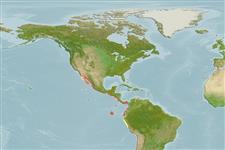Environment: milieu / climate zone / depth range / distribution range
Ecology
Marine; demersal; depth range 10 - 60 m (Ref. 91172). Tropical; 32°N - 18°S, 115°W - 71°W
Eastern Pacific: Mexico to Peru.
Size / Weight / Age
Maturity: Lm ? range ? - ? cm
Max length : 20.6 cm TL male/unsexed; (Ref. 91172); common length : 10.0 cm TL male/unsexed; (Ref. 9330)
Inhabits soft bottoms. Marketed fresh and may also be utilized as fishmeal.
Life cycle and mating behavior
Maturity | Reproduction | Spawning | Eggs | Fecundity | Larvae
Distinct pairing (Ref. 205).
Hensley, D.A., 1995. Paralichthyidae. Lenguados. p. 1349-1380. In W. Fischer, F. Krupp, W. Schneider, C. Sommer, K.E. Carpenter and V. Niem (eds.) Guia FAO para Identification de Especies para lo Fines de la Pesca. Pacifico Centro-Oriental. 3 Vols. FAO, Rome. (Ref. 9330)
IUCN Red List Status (Ref. 130435: Version 2024-2)
Threat to humans
Harmless
Human uses
Fisheries: minor commercial
Tools
Special reports
Download XML
Internet sources
Estimates based on models
Preferred temperature (Ref.
123201): 19.8 - 28.8, mean 25.9 °C (based on 70 cells).
Phylogenetic diversity index (Ref.
82804): PD
50 = 0.5000 [Uniqueness, from 0.5 = low to 2.0 = high].
Bayesian length-weight: a=0.00589 (0.00350 - 0.00989), b=3.27 (3.13 - 3.41), in cm total length, based on LWR estimates for this species & Genus-body shape (Ref.
93245).
Trophic level (Ref.
69278): 3.5 ±0.5 se; based on size and trophs of closest relatives
Resilience (Ref.
120179): High, minimum population doubling time less than 15 months (Preliminary K or Fecundity.).
Fishing Vulnerability (Ref.
59153): Low vulnerability (11 of 100).
